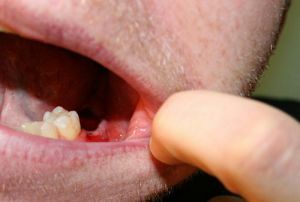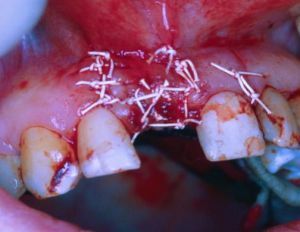 Tooth extraction is a painful, but sometimes necessary and responsible procedure for the doctor, since the patient's health depends on the correctness of the procedure.
Tooth extraction is a painful, but sometimes necessary and responsible procedure for the doctor, since the patient's health depends on the correctness of the procedure.
Any dentist after tooth extraction should put his fragments on a napkin to see if they are all pulled out of the gum. If the doctor is not sure that all the fragments are removed, he must send the patient to the X-ray. But due to oversight and ignorance, these manipulations are not performed by all doctors, and in this connection, a fragment remains in the gum after removal of the tooth. It is worth noting that this phenomenon may threaten complications and unpleasant consequences.
In the event that after you go to the dentist at home you found a fragment in the gum, you do not need to extract it yourself, you need to go to the doctor.
Contents
- What is the reason?
- Symptomatic
- How to remove a fragment?
- Than it threatens?
What is the reason?
As a rule, such a nuisance happens when removing wisdom teeth due to massive roots. Also the reason for this phenomenon can be that some teeth are deep in the oral cavity and the dentist is uncomfortable to consider whether all roots are extracted.

For other reasons, due to which the splinter may become a splinter, the following are attributed:
- breakage of the crown of the tooth, located next to the removed;
- damage to the gum or root of the tooth to be removed;
- low-quality work of the dentist.
Symptomatic
Many patients learn about the remains of the tooth in the gum, when they look in the mirror and see sticking out roots. But they do not always stay outside. Other symptoms that are characteristic for the condition, when after removal of the tooth, the patient had a fragment in the gum:
- pain at the site of the removed tooth within 24 hours;

- gingival puffiness;
- prolonged redness at the site of the removed tooth;
- chills;
- sensation of foreign body;
- increased body temperature;
- bad breath;
- appearance of pus.
Of course, and with properly performed extraction of the gum will be sick for a while. But if such a symptom persists for more than a week, it is an occasion to consult a doctor. A mandatory symptom of inflammation can be called a fever.
Very often patients come to the doctors with a complaint about splinters in the gums, noticing that there is something white in the place of the removed tooth. Sometimes a person sees the jawbone. In order to ensure that the patient does not experience discomfort, the dentist must pile up the edges of the dentist, which will eventually be pulled off with a soft cloth.
How to remove a fragment?
 If the gum still has a fragment left in the gum, the doctor must make an incision and extract all parts of the former tooth.
If the gum still has a fragment left in the gum, the doctor must make an incision and extract all parts of the former tooth.
It's not worth doing this yourself, because the fragments can sit deep and you can even injure the gum or infect the infection even more. In some cases, dental remains themselves drop out during the meal.
At home, you can take painkillers to relieve spasms. It can be Nurofen, Nimesil, Analgin, Ketonal.
Rinsing should not be done for two reasons:
- a water jet can trigger a fragment shift, and if it is near the nerve endings, this results in unpleasant consequences;
- independently it is difficult to estimate how deep the fragment has sat down, and therefore the procedure will be inconclusive.

After contacting a doctor, he can remove a tooth fragment in one of the following ways:
- Gum cutting and extraction of fragments .When they are located close to the gums, the doctor can remove the remaining parts of the teeth with tweezers. In some cases, the procedure is performed without damaging the gums.
- Deep gum cutting and strong anesthesia .This method is used if the roots are very deep.
In order to accurately determine whether the fragments remain after the operation, the doctor can send his patient to the X-ray room for a snapshot.
Than it threatens?
The splinter in the gum itself is a complication of a local nature, which is very common in medical practice. If it is not removed in time, then the inflammatory process will develop, and then suppuration.
But this is not all, sometimes the suppuration passes to the neighboring teeth, hitting a number of. But this is not all, if after the tooth has been pulled out, a fragment remains in the gum, it can cause a number of complications:
- periostitis;
- abscess;
- fistula;
- phlegmon;
- osteomyelitis.
Even a small remaining root can cause serious complications and suppuration. It must be remembered that the patient does not always notice a fragment in the gum from the removed tooth, since the morbidity of the gum and adjacent teeth is considered to be the norm after the operation.
And if the roots were "sitting" deep, then it would be impossible to notice the fragments on their own. In order to avoid unpleasant consequences, you only need to contact a certified clinic.
